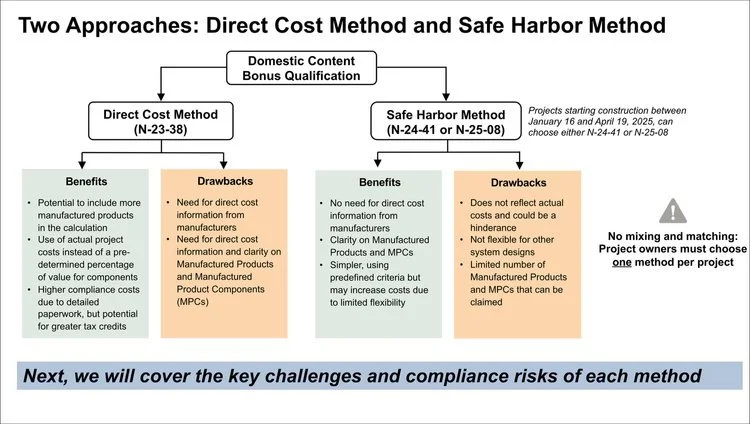Domestic content bonus tax credit guidance
Domestic Content Bonus: Benefits and Requirements
The U.S. Inflation Reduction Act (IRA) of 2022 brought multiple changes to clean energy manufacturing and deployment tax credits that support domestic clean energy manufacturing and a push for “on-shoring” of supply chains. One key IRA incentive is the Domestic Content Bonus.
What is the Domestic Content Bonus?
Provides a 2%/10% bonus to the Investment Tax Credit (ITC) and a 10% bonus to the Production Tax Credit (PTC) for projects meeting domestic content requirements.
Why It Matters:
Incentivizes U.S. Manufacturing: Drives expansion of PV cell factories, thin film solar production, and battery supply chains.
Supports On-Shoring: Encourages domestic sourcing of components, reducing reliance on foreign imports.
Key Supply Chain Impacts:
Boosts investment in U.S. manufacturing for solar PV and battery components.
Aligns with broader policy goals to shift critical mineral sourcing away from foreign entities of concern (FEOC).
Download the full Domestic Content Insights Report by completing the form to the right. This report covers:
Boosts investment in U.S. manufacturing for solar PV and battery components.
Aligns with broader policy goals to shift critical mineral sourcing away from foreign entities of concern (FEOC).
Download the full Domestic Content Insights Report by completing the form to the right. This report covers:
Domestic content bonus: Benefits and requirements
Two approaches to achieving domestic content:
Direct Cost Method (N-23-38)
Safe Harbor Method (N-24-41 or N-25-08)
Case studies
Strategies to achieve compliance
Have a Question or Need Assistance?
Learn more about the domestic content bonus
The quarterly published PV STPR covers global and regional supply chain analysis, technology trends, and regional policy analysis.
The PV Price Forecasting Report provides independent market intelligence on changes in global supply chains and accurate forecasts for supply price scenarios based on technologies, materials, manufacturing regions and target markets, as well as supply and demand forecasts and analysis.
The PV SMIP provides a comprehensive and unbiased analysis of the top PV module manufacturers in the world. It offers detailed insights into capacities, technology, and efficiency roadmaps, along with Manufacturing, Capacity, and Technology (MCT) ratings for each supplier.
The latest Energy Storage System (ESS) Supplier Market Intelligence Report includes concise and standardized analyses of major LIB cell suppliers and BESS integrators, focusing on global production capacities, product portfolios, and notable projects.
The quarterly Energy Storage STPR provides global and regional supply chain analysis, technology trends, and policy insights. This quarter focuses on innovations in container and system layout efficiency, as well as the UK’s new cap-and-floor regime for long-duration energy storage.
The ESS Price Forecasting Report provides an in-depth five-year forecast for the price of a DC battery container, including battery cells, modules, racking, and additional balance of system needed for a containerized battery system.
The PV Price Forecasting Report provides independent market intelligence on changes in global supply chains and accurate forecasts for supply price scenarios based on technologies, materials, manufacturing regions and target markets, as well as supply and demand forecasts and analysis.
The quarterly published PV STPR covers global and regional supply chain analysis, technology trends, and regional policy analysis through early July 2025.
The PV SMIP provides a comprehensive and unbiased analysis of the top PV module manufacturers in the world. It offers detailed insights into capacities, technology, and efficiency roadmaps, along with Manufacturing, Capacity, and Technology (MCT) ratings for each supplier.
The ESS Price Forecasting Report provides an in-depth five-year forecast for the price of a DC battery container, including battery cells, modules, racking, and additional balance of system needed for a containerized battery system.
The quarterly published Energy Storage STPR covers global and regional supply chain analysis, technology trends, and regional policy analysis. This quarter the focus is on new efforts for stackable BESS technology, the potential for non-lithium-ion technology as a tariff solution, and insights from a battery fire safety expert on myths vs. reality and best practices.
The latest Energy Storage System (ESS) Supplier Market Intelligence Report includes concise and standardized analyses of major LIB cell suppliers and BESS integrators, focusing on global production capacities, product portfolios, and notable projects.
This Interim Update of the Energy Storage System (ESS) Q1 2025 Price Forecasting Report highlights how newly imposed U.S. tariffs are reshaping the cost landscape for imported battery systems and components from China.
The latest Energy Storage System (ESS) Supplier Market Intelligence Report finds that the market landscape for lithium-ion batteries continues to evolve, and supplier strategy is shifting rapidly in response to the tariffs announced by the United States under the Trump administration, particularly on China, and persistently low prices.
The quarterly published Energy Storage STPR covers global and regional supply chain analysis, technology trends, and regional policy analysis. This quarter the focus is on non-lithium-ion technologies and the potential for long-duration energy storage.
The ESS Price Forecasting Report provides a five-year forecast for the price of a DC battery container, including battery cells, modules, racking, and additional balance of system needed for a containerized battery system. The Q1 2025 report covers pricing outlook updates through March 2025.
The PV SMIP report provides a comprehensive and unbiased analysis of the top PV module manufacturers in the world. It offers detailed insights into capacities, technology, and efficiency roadmaps, along with Manufacturing, Capacity, and Technology (MCT) ratings for each supplier.
The quarterly published PV STPR covers global and regional supply chain analysis, technology trends, and regional policy analysis.
The PV Price Forecasting Report provides independent market intelligence on changes in global supply chains and accurate forecasts for supply price scenarios based on technologies, materials, manufacturing regions and target markets, as well as supply and demand forecasts and analysis.
The quarterly published Energy Storage STPR covers global and regional supply chain analysis, technology trends, and regional policy analysis. This quarter the focus is on non-lithium-ion technologies and the potential for long-duration energy storage.
The PV SMIP provides a comprehensive and unbiased analysis of the top PV module manufacturers in the world. It offers detailed insights into capacities, technology, and efficiency roadmaps, along with Manufacturing, Capacity, and Technology (MCT) ratings for each supplier.
The quarterly published PV STPR covers global and regional supply chain analysis, technology trends, and regional policy analysis. This quarter, the regional analysis includes CEA’s policy and supply analysis in China, Europe, the United States, and India.
The ESS Price Forecasting Report provides an in-depth five-year forecast for the price of a DC battery container, including battery cells, modules, racking, and additional balance of system needed for a containerized battery system.
The latest Energy Storage System (ESS) Supplier Market Intelligence Report finds that overall planned capacity continued to decline as project cancellations and delays continue to mount on the growing lithium-ion industry due to softer-than-expected EV demand.
The latest Energy Storage System (ESS) Supplier Market Intelligence Report finds that weak global EV demand growth continued to affect planned cell manufacturing capacity.
The quarterly published Energy Storage STPR covers global and regional supply chain analysis, technology trends, and regional policy analysis. This quarter the focus is on the ramp-up of energy capacity per container and container shipping trends.
The ESS Price Forecasting Report provides an in-depth five-year forecast for the price of a DC battery container, including battery cells, modules, racking, and additional balance of system needed for a containerized battery system.
The PV Price Forecasting Report provides independent market intelligence on changes in global supply chains and accurate forecasts for supply price scenarios based on technologies, materials, manufacturing regions and target markets, as well as supply and demand forecasts and analysis.
The PV SMIP provides a comprehensive and unbiased analysis of the top PV module manufacturers in the world. It offers detailed insights into capacities, technology, and efficiency roadmaps, along with Manufacturing, Capacity, and Technology (MCT) ratings for each supplier.
The quarterly published PV STPR covers global and regional supply chain analysis, technology trends, and regional policy analysis. This quarter, the regional analysis includes CEA’s policy and supply analysis in China, Europe, the United States, the Middle East, and India. Technology trends continue to cover TOPCon and HJT degradation.

































